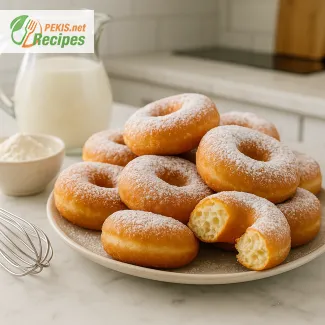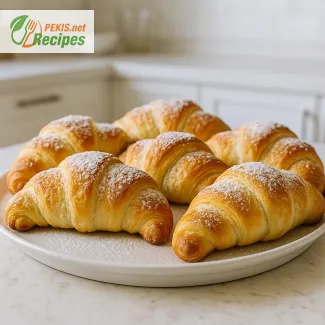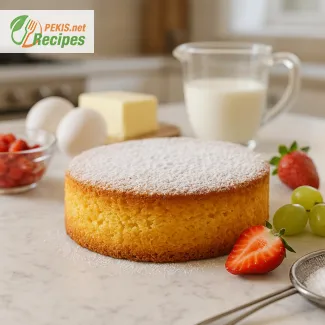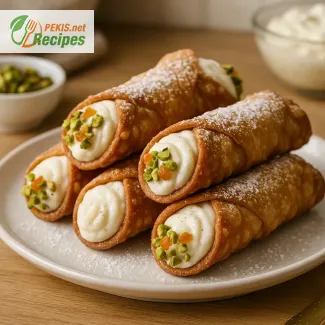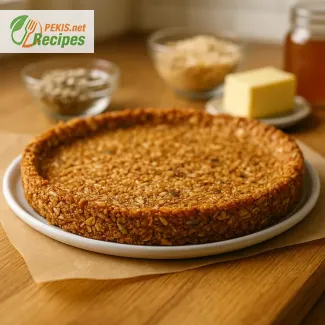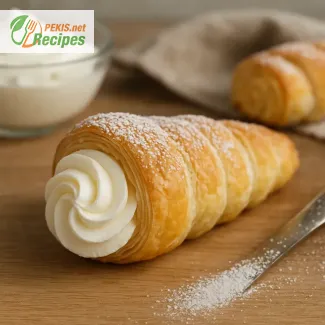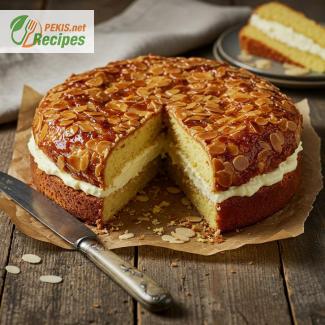
Discover the Delicate Delight of Traditional German Bee Sting Cake
A timeless fusion of honey, almonds, and creamy indulgence in every slice
When it comes to European desserts that enchant both the eyes and the palate, few can rival the irresistible charm of the Bee Sting Cake, known in Germany as Bienenstich. This iconic cake, with its golden honey-almond crust and velvety vanilla custard filling, represents a celebration of texture, flavor, and craftsmanship that has endured for generations. Rooted in German baking tradition, the Bee Sting Cake carries a story as rich as its layers, making it not only a dessert but a conversation piece at any gathering.
The name “Bee Sting Cake” may raise an eyebrow at first, but the story behind it only adds to its allure. As legend goes, the cake earned its name when medieval German bakers fended off raiders with beehives, later commemorating the victory with a dessert sweetened with honey – the symbolic ingredient that defines this cake. While the tale may vary, the ingredients remain true: fluffy yeasted dough, silky pastry cream, and a crackling caramelized almond topping.
Unlike many sponge-based cakes, Bienenstich starts with a lightly sweetened yeast dough, lending it a texture that's both airy and satisfying. It’s a unique hybrid – not quite a bread, not quite a cake – that sets it apart from other layered desserts. What elevates it even further is the buttery honey glaze draped over thinly sliced almonds, creating a glossy, crunchy crown that contrasts beautifully with the soft interior. Sandwiched between these layers is a generous filling of vanilla custard or cream, often enriched with whipped cream for extra lightness.
Homemade Bee Sting Cake is a labor of love, but every step is rewarded with a finished product that is both elegant and deeply comforting. Whether served as an afternoon treat with coffee or as the grand finale to a dinner party, this cake never fails to impress. Each bite offers a balance of sweet, nutty, creamy, and slightly chewy elements, orchestrated into perfect harmony. It’s no wonder that Bienenstich remains a staple in German bakeries and continues to gain popularity across kitchens worldwide.
Today, modern interpretations may vary – some use pudding mixes, some opt for buttercream fillings, and others tweak the topping with additions like orange zest or sea salt. But at its heart, a true Bienenstich maintains the same pillars: a yeasted base, a rich filling, and a caramelized almond top. The contrast between the soft dough and the brittle topping is more than just texture – it’s a symbol of how simplicity and sophistication can coexist in one dessert.
For those seeking a taste of authentic German cuisine, the Bee Sting Cake offers more than just flavor – it brings a piece of culinary heritage to your table. It captures the essence of comfort baking while offering a touch of luxury, ideal for special occasions, family celebrations, or simply when you want to treat yourself to something extraordinary.
This is the kind of cake that tells a story. From its rustic origins in the German countryside to its modern place among internationally loved desserts, Bienenstich is proof that good recipes are timeless. It transcends cultural borders and continues to delight both young and old, making it a must-bake recipe for anyone who values quality ingredients, tradition, and the joy of homemade desserts.
Stay tuned for the full step-by-step Bee Sting Cake recipe, including exact measurements, preparation tips, and everything you need to bring this German classic into your kitchen.
1. Prepare the yeast dough:
Warm the milk to about 37°C (98°F) and mix in the sugar and dry yeast. Let it sit for 10 minutes until frothy. In a large bowl, combine flour and salt. Add the yeast mixture, melted butter, and eggs. Knead into a smooth dough (about 10 minutes by hand or 5 minutes with a mixer). Cover and let rise in a warm place for 60–90 minutes until doubled.
2. Make the almond-honey topping:
In a saucepan, melt butter with sugar, honey, and cream. Let it gently boil for 2 minutes, then stir in sliced almonds. Let cool slightly.
3. Shape and bake the dough:
Line a 26 cm (10-inch) springform pan with parchment. Roll the dough into a circle and place it into the pan. Spread the almond-honey mixture evenly on top. Let rise again for 30 minutes. Bake in a preheated oven at 175°C (350°F) for 25–30 minutes until golden and bubbling. Let it cool completely.
4. Prepare the custard cream filling:
In a saucepan, heat the milk until steaming. In a separate bowl, whisk together sugar, cornstarch, egg yolks, and vanilla. Slowly pour the hot milk into the egg mixture while whisking. Return to heat and cook on medium, stirring constantly, until thickened. Remove from heat and stir in butter. Cover with plastic wrap and chill for 2 hours. Once cooled, whip the cream and fold it gently into the custard.
5. Assemble the cake:
Slice the cooled cake horizontally with a serrated knife. Carefully remove the top layer. Spread the custard cream evenly over the bottom layer. Place the almond-covered top layer back on. Chill the cake for at least 1 hour before serving to allow it to set.
Elevating the Bee Sting Cake: Creative Twists and Expert Tips
Explore clever ways to enrich flavor, texture, and presentation in your homemade Bienenstich
Transforming a classic like the Bee Sting Cake into a personalized masterpiece doesn't require reinventing the wheel. Instead, it invites us to deepen our understanding of its core elements and to gently adjust techniques and ingredients in ways that elevate this timeless dessert. Whether your goal is to enhance flavor complexity, improve texture, or make it more health-conscious, small changes can bring out big results. The original recipe provides a solid foundation, but home bakers can use their creativity and know-how to bring out the very best in each slice.
Enhancing the filling for greater richness and flavor
The heart of any Bee Sting Cake lies in its creamy center. Traditionally made with pastry cream or a vanilla custard folded with whipped cream, this layer offers plenty of room for personalization:
- Add mascarpone cheese to the filling (about 100 g / ½ cup) to create a denser, richer texture that complements the sweetness of the almond topping.
- For a floral touch, infuse the milk with lavender or orange blossom water before making the custard. Just a teaspoon can bring elegant aromatic depth without overpowering.
- Introduce white chocolate shavings to the cream for added sweetness and a melt-in-the-mouth finish. It works especially well when paired with a more robust dough.
- If you prefer a slightly tangy profile, blend in cream cheese with the custard, balancing the honeyed topping with a subtle sharpness.
Each variation subtly shifts the flavor balance, turning the cake from a standard classic into a custom dessert that reflects your taste.
Upgrading the dough for texture and structure
The yeast dough in Bienenstich is crucial—it supports both the weight of the almond topping and the softness of the cream layer. Small tweaks can change the texture dramatically:
- Swap out 100 g (¾ cup) of white flour for fine spelt flour to give the cake a nuttier flavor and a more rustic bite.
- Replace half the milk with buttermilk to introduce a gentle tang and a more tender crumb.
- For an airier result, let the dough rise twice, punching it down in between. This ensures a lighter, more open structure.
- Want more buttery richness? Add an extra egg yolk or increase the butter by 10–15 g. This makes the cake slightly denser but incredibly flavorful.
Avoid over-kneading, which can make the dough rubbery, or under-proofing, which can result in a flat, overly dense base.
Elevating the almond topping for added depth
The topping is what gives the Bee Sting Cake its signature crunch and sweetness. It's also where small additions can dramatically enhance the flavor:
- Stir in a pinch of sea salt to the caramel-honey mixture to balance out the sweetness and intensify the nutty notes.
- Add a splash of dark rum or amaretto to the topping for a more complex, slightly boozy undertone—perfect for adult palates.
- Experiment with other nuts, such as chopped hazelnuts or pistachios, or combine them with almonds for a more layered texture.
- Sprinkle in lemon zest or orange zest to cut through the richness and add freshness.
One common mistake is overheating the topping, which can make it brittle and overly hard. Keep the cooking time short and don’t overboil the caramel.
Health-conscious substitutions and lighter alternatives
For those seeking a lighter version of this indulgent dessert, you can still enjoy the Bee Sting Cake without sacrificing its essence:
- Use low-fat milk or plant-based milk such as almond or oat milk in both the dough and custard.
- Swap out sugar with coconut sugar or erythritol (though you may need to adjust quantities for sweetness levels).
- Instead of full-fat butter, try unsalted plant-based spreads or even avocado oil-based margarine for a more heart-healthy option.
- Replace the whipped cream in the filling with silken tofu blended with vanilla extract and a natural sweetener for a protein-rich, dairy-free alternative.
Keep in mind that while substitutions can help reduce calories or suit dietary needs, they may slightly alter the final flavor and texture. It’s often best to test these changes in smaller batches before serving them to guests.
Why homemade always wins
While you can find Bee Sting Cake in specialty bakeries, homemade versions have unique advantages. Fresh ingredients, no preservatives, and the ability to adjust flavor intensity make every slice more personal. Home bakers can control sugar content, customize the filling-to-dough ratio, and even fine-tune baking times for optimal results.
Beyond the technical aspects, baking this cake at home offers a sense of accomplishment and a chance to connect with culinary tradition. Preparing the yeast dough, simmering the honey topping, and assembling the layers all require care—resulting in a more satisfying and rewarding dessert experience.
Troubleshooting common mistakes
To ensure perfect results, watch out for these frequent pitfalls:
- Cream too runny: Always cool the custard completely before folding in whipped cream. Otherwise, it may deflate or become watery.
- Topping separation: Stir continuously while making the topping to prevent the honey from separating from the butter.
- Underbaked dough: Make sure the base is fully baked before slicing. The center should be springy but firm, and the top lightly golden.
- Soggy middle layer: Avoid assembling the cake while the base is still warm. Let all layers cool fully to prevent melting the cream.
Presentation ideas for special occasions
For holidays or celebrations, consider elevating the presentation:
- Dust the top with powdered sugar just before serving for an elegant finish.
- Pipe a border of whipped cream or rosettes around the edge for a more festive look.
- Add a layer of fresh berries like raspberries or strawberries on top of the cream before assembling. This adds color, freshness, and a slight acidity that cuts through the richness.
You can also bake individual portions in small round molds or muffin tins to serve mini Bee Sting Cakes—ideal for brunches or dessert tables.
Modernizing a classic
While the traditional Bee Sting Cake is already a masterpiece, small modifications allow home bakers to adapt it for personal taste, occasion, or dietary preference. Whether you’re elevating the almond topping, exploring new fillings, or simply making it a bit healthier, every thoughtful change deepens your connection to the recipe. This dessert invites creativity, rewards precision, and always delivers comfort—making it a timeless favorite that continues to evolve with every generation.
Allergens present in this recipe:
- Gluten (wheat flour)
- Dairy (milk, butter, cream)
- Eggs
- Tree nuts (almonds)
Substitution tips to remove allergens and gluten:
- Gluten-free: Use a 1:1 gluten-free flour mix with xanthan gum.
- Dairy-free: Replace milk and cream with plant-based alternatives like almond or oat milk. Use vegan butter and coconut cream.
- Egg-free: Use an egg replacer or a mixture of flaxseed meal and water (1 tbsp flax + 3 tbsp water per egg).
- Nut-free: Replace almonds with sunflower seeds or omit topping entirely.
- Vitamin B2 (0.25 mg): Supports energy metabolism and red blood cell production
- Calcium (105 mg): Important for bone and dental health
- Magnesium (38 mg): Supports muscle function and reduces fatigue
- Phosphorus (120 mg): Supports cell repair and energy transfer
- Iron (1.1 mg): Helps transport oxygen in the blood
- Zinc (0.7 mg): Strengthens the immune system
- Vitamin A (180 µg): Essential for vision and immune function
- Vitamin D (0.8 µg): Regulates calcium absorption and bone health
- Vitamin E (2.5 mg): Protects cells from oxidative stress
- Polyphenols from almonds and honey (~60 mg): Support heart health and reduce inflammation
- Flavonoids from vanilla and honey (~30 mg): May help improve vascular health and brain function
